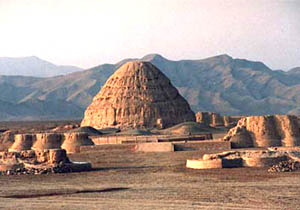
Dubbed by locals the "Pyramids of China," the Western Xia Tombs (Xixia wangling) contrast sharply from some of their more famous counterparts further north.
In contrast to the wooden and stone structures of the Ming and Qing imperial tombs, the Western Xia Tombs are earth and brick structures which reflect the culture of the ancient western kingdom.
Located 30 kilometers west of Yinchuan, the capital of Ningxia Hui Autonomous Region, the Western Xia Tombs include nine mausoleums housing the imperial family and 207 tombs of dukes and ministers.
Covering an area of 40 square kilometers, these buildings are located on the eastern slope of the Helan mountain range and just to the south of the Gunzhong Pass.
These edifices are a magnificently crumbling sight by day or night.
The tombs were originally created by the founder of the Western Xia Kingdom (1038-1237 AD), Li Yuanhao, who built over 70 tombs, one for himself, a number for his relatives and more to be left empty, presumably against theft.
Each main tomb has four corner towers, and an array of watchtowers, pavilions housing stone tablets, a sacrificial hall and a coffin platform, although most of these buildings are well beyond recognizable.
Archaeologists believe that octagonal glazed-tile pagodas once stood by each tomb.
In the war against the ancient Mongolian army from 1220 to 1227, Western Xia Kingdom failed and the imperial tombs were damaged.
Today's visitors to the sites can only find piles of relics.
Excavation has been completed on one main tomb and on four of the annexes. The main tomb is believed to be that of Li Yuanhao, and all the tombs have a stairway or sloping path down to their coffin pits.
In the wake of the poor maintenance and heavy erosion, most of the buildings are now fairly dilapidated, made from crumbling brown earth and scattered across the plain.
Fortunately, building materials, broken stone tablets, towers, glazed tiles, walls and steles with inscriptions of Western Xia or Han characters still remain, and provide visitors with interesting information on the Western Xia.
Lots of treasures, arts and sculptures were unearthed from Li Yuanhao's mausoleum and are on display in the Western Xia Museum, which is located near the entrance of Li's tomb. Other cultural artifacts and relics related with ancient Western Xia were also collected from across China and exhibited here.
The talk by the Chinese guide (with the surname Li) in the museum is very attractive. He is one of the few experts in China to contribute to the research work of Western Xia Kingdom and Emperor Li Yuanhao.
The main attraction nearby is the Gunzhong Pass (Gunzhong kou), which is a part of the Helan mountain range.
This is a perfect area for hiking and admiring the scenery of one of China's least-travelled provinces. Gunzhong literally translates as "rolling bell," and the pass was so named because it resembles a lying bell, with the bell mouth opened to the east, and the mountains forming the bell surface in the other three points of the compass.
This is one of Helan mountain's most famous sights, about 35 kilometers northwest of Yinchuan.
Also the famous Xibu Yingshicheng (Western Film and Television City) is five kilometers north of the tomb area. Many Chinese films were shot there.
How to get there: Flights are available in many Chinese cities like Beijing, Shanghai and Hangzhou. It usually takes an hour from Beijing to Yinchuan by air and costs about 800 yuan (US$96). Generally, there is no travel peak in Ningxia so many airlines offer huge discounts if going there by air. Train routes are numerous from Beijing to Yinchuan (about 200 yuan/US$24 for a sleeping berth). It takes 12 hours.
From Yinchuan to Western Xia Tombs, visitors usually take bus route No 17 to the terminus, and then catch a taxi or motor-rickshaw for the remaining 10 kilometres (10 yuan/US$1.2).
Notes: The Hui people are very hospitable and warmhearted to visitors from other areas. But it would be foolish to upset various religious taboos.
Generally your guide will offer you useful suggestions once you arrive at Yinchuan Airport.
(China Today February 11, 2004)
|

